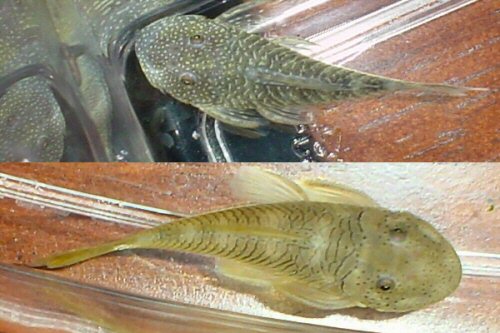Striped Rubber Pleco
- Thread starter OldVamp
- Start date
It looks like either a slightly different pleco or a hybrid. Not sure which but definitely a cool one. First I thought it was just a color variant from another region (it still could be this) but that is my guess. Anyway, hope this helps.
My LFS often gets those two rubberlip variants in at the same time from their supplier. I think they come from the same area and just get caught together.
Eric
Eric
I would seriously doubt its a hybrid. The Chaestoma aren't all that readily spawned, as far as I know. I would say its two locational variants, but the actual pattern on the fish is similar, along with shape, its just the base color that varies. That may change once both fish acclimate to your tank and get used to the substrate and what not. Changes in basic colorations can vary greatly in plecos, even from day to day.
Barbie
Barbie
I meant a hybrid in nature. Fish do hybridize in nature too and it is a lot more natural looking than what humans do to them.
Rarely are two "variants" found within a close enough location to risk hybridization, and fish tend to be able to tell the difference between species far more readily than we can, IME. Hybridization is usually not a factor that I would assume with Loris. It's far from common.
Barbie
Barbie
I got both of those types here sold as rubber lips too.  The one with the spots is quite pretty. I've had them for months now and they have kept the same markings. I have two with stripes and just the one with spots.. They do a great job on the side of the aquarium and seem to grow very slowly. I had put one in my ten gallon that was about the size of an oto to grow it out before putting it in a larger tank but it has grown less than half an inch in over a year. They also don't seem to *work over* broadleaf plants as bad as bristlenoses either.
The one with the spots is quite pretty. I've had them for months now and they have kept the same markings. I have two with stripes and just the one with spots.. They do a great job on the side of the aquarium and seem to grow very slowly. I had put one in my ten gallon that was about the size of an oto to grow it out before putting it in a larger tank but it has grown less than half an inch in over a year. They also don't seem to *work over* broadleaf plants as bad as bristlenoses either. 
Well, a prominant example of this often happening in nature are species of the Symphysodon genus (discus). There are several color variants which interbreed as well as hybrids between Symphysodon discus and Symphysodon aequifasciatus.Rarely are two "variants" found within a close enough location to risk hybridization, and fish tend to be able to tell the difference between species far more readily than we can, IME. Hybridization is usually not a factor that I would assume with Loris. It's far from common.
There are also hybrids, in nature, I believe, between Pelvichromis pulcher and Pelvichromis taenius(sp?) but I could be wrong.
Fact is, many species of animals and plants hybridized quite readily. Hybridization, I also believe, often leads to the developement of new, more evolved species, but I could also be wrong there.
Color morphs of discus are not separate species, they are color morphs, therefor the offspring would not be hybrids, just a new color morph. Not the same thing at all.
Pelvicachromis taeniatus and pulcher would create hybrid fry, IF they were to cross spawn. Pulcher are found in branches and pond extensions of the small Ogba river, south of Benin city, Southern Nigeria, while taeniatus are collected in Nigeria and Cameroon. I would definitely need to see documentation of that hybridization being a common occurence to believe it, personally.
Fish actually CAN tell the difference between species that people have difficulty discerning or there would be very little variation between the two species if they intermixed freely. Its basically what the classifications are based on, those unique differences.
Barbie
Pelvicachromis taeniatus and pulcher would create hybrid fry, IF they were to cross spawn. Pulcher are found in branches and pond extensions of the small Ogba river, south of Benin city, Southern Nigeria, while taeniatus are collected in Nigeria and Cameroon. I would definitely need to see documentation of that hybridization being a common occurence to believe it, personally.
Fish actually CAN tell the difference between species that people have difficulty discerning or there would be very little variation between the two species if they intermixed freely. Its basically what the classifications are based on, those unique differences.
Barbie






